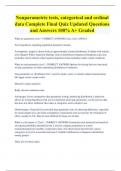Nonparametric tests, categorical and ordinal
data Complete Final Quiz Updated Questions
and Answers 100% A+ Graded
What are parametric tests? - CORRECT ANSWER-t-test, z-test, ANOVA
Tests hypotheses regarding population parameter (means)
Assumptions: sample is drawn from an approximately normal distribution. Confirm with statistic
tests (Shapiro Wilks; Anderson Darling), look at distribution (frequency histogram),some non-
normality can be tolerate (robust against departures from normality) under certain conditions
What are non parametric tests? - CORRECT ANSWER-Options for testing data not concerned
w/ pop. parameters or where underlying distribution is unknown
Non-parametric or "distribution free", used for ranks,s cores, or similar ordinal measurements
like apgar scores or pain scales.
Measures using categories.
Badly skewed continuous data
Advantages: fewer assumptions than parametric testing, underlying distribution is unknown,
allows for testing hypotheses that are not statements about pop parameters, can be used on data
that does not allow arithmetic like ranks or categories, and is simple to use
Disadvantages: Generally less powerful than parametric tests for detecting difference, especially
for small sample sizes and when assumptions of parametric tests are present. No estimation of
effect, usually no CIs. May be more difficult for large sets of data.
What is a chi-square x^2 test? - CORRECT ANSWER-Commonly used statistical test based on
chi-square probability distribution that is used to compare proportions or counts
(nominal/categorical variables, enumerative data- # of observations that fall into various
categories) to test for association between 2 variables (differences in frequency distribution
among groups)
There are two basic types:
,Test for goodness of fit: based on data from a single sample, compares to a known or standard
result
Test of independence: 2 or more samples, assesses categorical explanatory variables to see if
they are associate or independent, also known as pearson's chi-square or chi-square test
Variations on Pearson's chi-square
Mantel-Haenszel
Cochran Mantel-Haenszel
What is a chi-square distribution? - CORRECT ANSWER-It has a skewed (+) distribution
(bulges at the back)
Mean = degrees of freedom (df)
Represented by x^2
It is used to compare with a chi-square test for number of observed counts to expected counts
(expected=frequency of event if variable had no effect on outcome). Looks for deviations from
what was expected and the magnitude of the deviation
No independence of explanatory variables: Observed O = Expected E
Independence: O ≠ E
Assumptions: random sampling, independent observations, mutually exclusive categories, and
large frequencies of expected events
How is data for a chi-square test presented? - CORRECT ANSWER-In a contingency table, 2x2.
df= (rows-1)(columns-1) N= grand total, n1= a+C, n2 = b+d, m1 = a+b, m2=c+d
How do you calculate for a chi-square test? - CORRECT ANSWER-Compare calculated x^2
statistic to critical value from x^2 table
X^2 calc > crit, then reject H0
X^2 calc < crit, then fail to reject H0
What are the steps to apply a chi-square test? - CORRECT ANSWER-State H0
Arrange data in 2 x 2 table w/ observed and marginal frequencies
, Determine x^2 critical value based on alpha and df
Calculated expected frequencies: (row total x column total) / (Grand total)
Calculate X^2 statistic: x^2 = Sum of (O-E)^2/E
Compare calc stat to crit value
You're in an anti retroviral study determining efficacy of a new drug in combination with reverse
transcriptase inhibitors for HIV. Patients were either protease inhibitor naive or had history of
use.
In the PI naive group, 26 patients completed outcome of 120 weeks of follow-up, with 71 not
In other group, 19 patients completed outcome, 77 did not.
Calculate a chi-square for this - CORRECT ANSWER-H0= Proportion of patients remaining for
120 weeks of follow up is not different between treatment naive and previously treated patients
Group 1 = Group 2
Calculations:
df=(2-1)(2-1)=1
Alpha=0.05
X^2 crit=3.841 (from table, 1 df 0.05 alpha upper tail)
Yes, No, Total
PI naive: 26, 71, 97
PI users: 19, 77, 96
Total: 45, 148, 193
Calculate expected frequencies:
Row total x Column Total/Grand Total
Row 1, Column 1: 97 x = 22.6
R2, C1: 96x45/193=22.3
R1, C2: 97x148/193=74.3
R2, C2: 96x148/93=73.6
R1, C1: O-E = 26 - 23 = 3. (O-E)^2 = 9. (O-E)^2/E = 9/23 = 0.391





